FIELD VETERINARY REPORT FOR SOUTHERN CONSERVATION AREA MOBILE VETERINARY UNIT FOR THE MONTH OF FEBRUARY; 2018 Reported by Ndambiri Ephantus
FIELD VETERINARY REPORT FOR SOUTHERN CONSERVATION AREA MOBILE VETERINARY UNIT FOR THE MONTH OF FEBRUARY; 2018
Reported by Ndambiri Ephantus.
Introduction
The month under review has been characterized by sudden decrease in vegetation cover as temperatures have soared. Within the community conservancies the savannahs once full of grass and over flowing water pans have all disappeared. Wildlife has flooded into the park which still has essential viable habitat. Domestic animals have also been herded into the park causing an unbearable pressure on the limited resources. We hope that things will change over the following months as there are signs of eminent rain at the end of the month. Conservation efforts have been geared towards marking dispersal routes of the animal during this dry period of the year. This has been achieved by a collaring exercise conducted on elusive troublesome elephants in order to help in curbing human-wildlife conflict.
Following are veterinary activities attended to during the month;
CASE # 1 ELEPHANT COLLARING EXERCISE
Date: 12-15/2/2018
Species: Elephant
Sex: 4 Males & 1 Female
Age: Adults
Location: Amboseli Ecosystem
History
The Amboseli ecosystem has face many challenges, both man-made and natural. Humans continue to open land for cultivation on one hand while nature continue to be conducive due to global warming. As resources dwindle a common interest is set at water and foliage sources resulting to conflict. This results in increased human-wildlife conflict. Wild animals are constantly on the move to look for fresh foliaging areas and so are pastoralists. There is need to mark these dispersal areas and new habitable locations so that better planning can be put in place to secure the corridor and also identify possible conflict areas.
A pre-collaring survey was done one week preceding the exercise in order to locate areas where predetermined candidates were for effective collaring. Candidates were identified as middle aged males because they are more likely to break fences, crop raid and travel long distances looking for mates. Targeted age was between 25 and 35 years old. Five different locations were identified and four new collars and one old were deployed on individuals concerned.
This exercise was a partnership between the KWS and IFAW. The individuals were darted from a helicopter due to the difficult terrain. It was possible to clearly identify the candidates and drive them into open areas where the ground team could easily deploy the collars and ensure safety of the animal and personnel security. A fixed wing was used for locating individuals and directed the crew to possible locations. Personnel included teams from Nairobi KWS Hqs, Amboseli Park, Community Conservancies and IFAW.
The exercise was scheduled for three full working days but it was accomplished successfully within two days because of the marvelous team work.
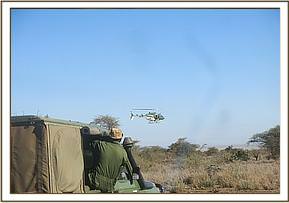
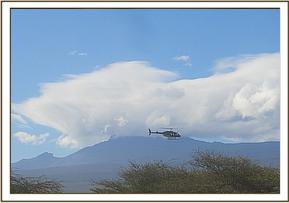
Immobilization
Darts were prepared using three centiliter darts in which 18mgs Etorphine were used and the rest of dart filled with water for injection. Immobilization time was ten minutes on average. On average the collaring exercise took fifteen minutes and the vet unit monitored the animal throughout. Animals were dowsed with water especially on the ears because of high ambient temperatures. Trunks were straightened and a piece of stick placed at the open end across to maintain patency.
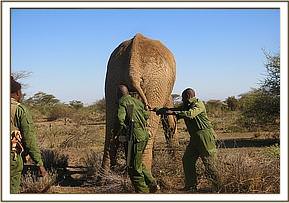
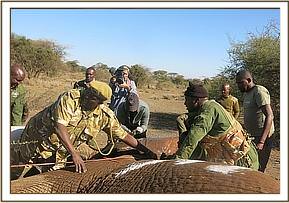
Collaring, Sampling and Treatment
None of the candidates had any injury necessitating treatment. Body conditions were between 3 and 4 at scale of 1-5 with one being poorest and five being best. Collars were fitted by the collaring team and the parameters recorded included the frequencies, identities, lengths together with animal bio data. Other samples included whole blood in cryovials preserved in liquid nitrogen, ticks in absolute alcohol and in reta and another frozen in liquid nitrogen, ear tissue in absolute alcohol and fecal samples preserved in formalin. All were delivered to KWS Hqs Laboratory for different analysis.
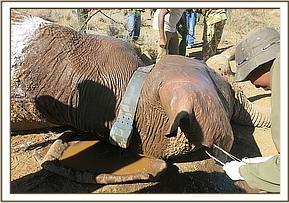
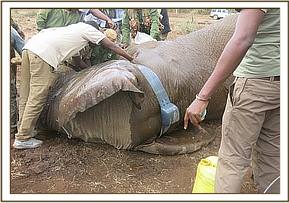
Reversal
All candidates were reversed using 12mgs Diprenorphine and 40mgs Naltrexone in one single syringe. It was administered intravenously into the ear vein after directing everyone to be in the vehicle and at a safe distance. On average the reversal time was two minutes post reversal administration. Each got back on all fours energetically and walked away.
Prognosis
All candidates were in good prognosis as there was no complication experienced during the exercise.
CASE #2 BABY ELEPHANT RESCUE
Date: 13/2/2018
Species: Elephant
Sex: Male
Age: Calf
Location: Amboseli National Park
History
The Amboseli Park Security team while on patrol came across a baby elephant which had plunged into a water hole. The calf’s’ trumpets attracted the patrol team. They went closer and noticed the calf submerged. They tried to extract the calf manually but the aggressive mother emerged from a nearby bush and charged the team. The team took off as the mother chased them away and returned to keep watch at the water hole. It was for sure that the team could not successfully rescue the calf thus they called the vet team which was at Kuku Conservancy collaring the third elephant of the day schedule. We had just finished collaring and so quickly set out as we had a window of less than an hour and a half to travel a hundred kilometers rough road and complete the rescue before night fall.
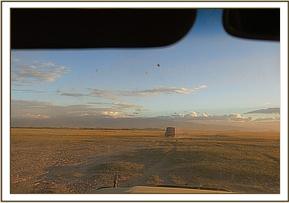
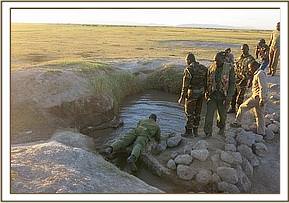
Rescue
We met the security team a kilometer away from the site at 6:45pm. The mother was nowhere to be seen but we presumed she had not gone far. We assessed and found that it could be reached by hand. It was floating silently but begun trumpeting after seeing humans. We kept two security personnel on watch as we embarked to get the calf out.
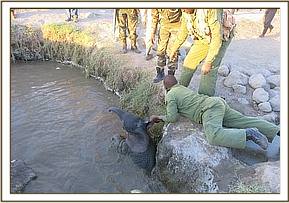
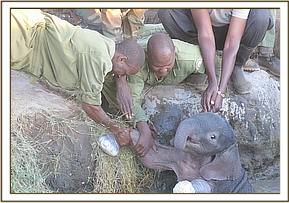
The calf was held by ears exposing the limbs and with the help of five able men, it was successfully removed out of water. It was still energetic and ambulating depicting suckling reflex.
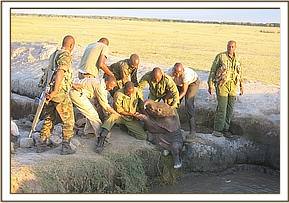

The next move was to try and locate the mother within the vicinity quickly. It was placed in one of the open pick up and we drove in different directions searching for the dam.
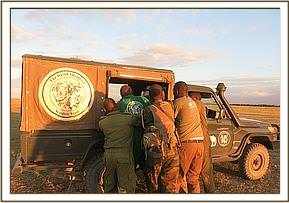
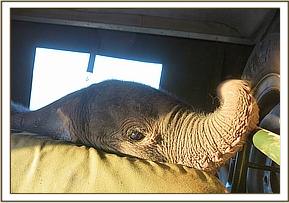
The mother heard the baby trumpet and after only covering less than a kilometer towards nearby shrubs we spotted the mothers’ trunk above the shrubs picking scent to our direction and presumed she was the one. We quickly stopped and off loaded the calf from the pick-up. By this time mother was about a hundred meters away. The calf trumpeted again and the mother charged. We quickly took off and she charged at us for about fifty meters before going back to the calf. She inspected it and recognized it. She offered it teats to suckle and it was a successful reunion.


Prognosis
Has a fair prognosis. Hopefully there won’t be any pneumonia complications.
CASE #3 BABY ELEPHANT RESCUE
Date: 15-16/2/2018
Species: Elephant
Sex: Female
Age: Calf
Location: Amboseli National Park
History
In the evening, the vet team received a call from Amboseli Park security team concerning a stuck and abandoned calf at an edge of a swamp near Observation Hill course way. It was already night making it very difficult to trace the mother and organize transport to the elephant nursery if needed. We rushed to the scene and found the calf fully submerged in sticky clay mud. The area appeared ragged depicting mothers’ efforts to pull it out. Nearby there were two males outside the swamp with another family of seven members inside the swamp. Despite the calf desperate trumpets they seemed uninterested. We anticipated resistance from them but to our surprise we got none.
We assessed and moved to the edge quickly.
Rescue
The only part of the calf visible was the top of the head and upper part of the ears. Its’ trunk was exposed making breathing possible. We held it by ears and tried to fish the front limbs from the mud. Eventually with the help of four men, the calf was pulled out of the mud after a struggle. It was cleaned using clean water. We tried to test the nearby herd’s interest by placing the calf close by and drive them towards it. We were surprised by the reaction of one female which knocked the calf not once but thrice to the ground upon any approach. We quickly recovered the calf and called the DSWT nursery.
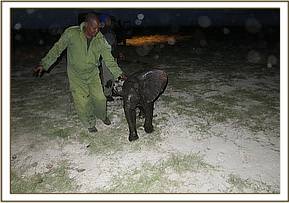
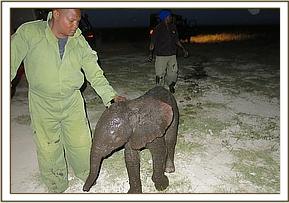
The calf was to spend a night at Amboseli Park Hqs so that it could be collected the next morning by a chartered air plane. It was given plain water and was still strong. It was kept in a padded warm room till the following day. There was frequent contact with DSWT on the progress of the rescue exercise and status of the calf.

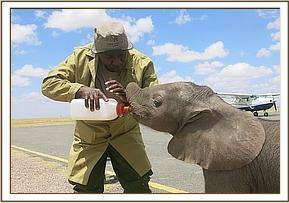
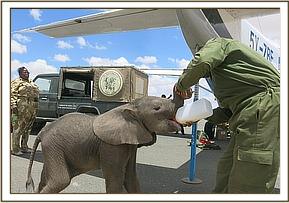
Prognosis
It was given fair prognosis though it needs to be monitored for any possible complications suffered before rescue such as pneumonia, internal injury etc.
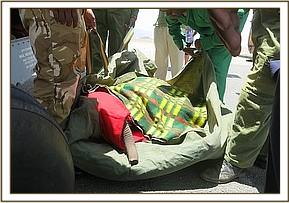
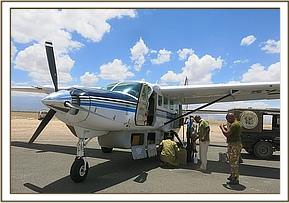
CASE #4; ZEBRA TREATMENT
Date: 20/02/2017
Species: Zebra
Sex: Male
Age: Adult
Location: Amboseli National Park
History
The Amboseli Mobile Vet Unit found an isolated grazing zebra while on usual patrol within the park. This elicited our interest as to why the zebra was alone. We urged it to move only to realize that it was lame on the left hind limb. The limb was heavily soiled with sticky mud obscuring any meaningful observation. The lameness was severe necessitating immobilization for effective examination of the swollen limb.
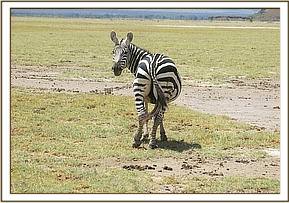
Immobilization, examination and treatment
The candidate was darted from the vehicle using 4mgs Etorphine and 70mgs Azaperone topped up with water for injection. It was approached quietly and the dart propelled using Dan-Inject dart gun. The dart landed in the right thigh and zebra took off to a distance of about thirty meters and was totally immobilized in three minutes assuming left recumbence. It was recovered quickly and turned to right recumbence to facilitate observation. A blindfold was placed on the eyes to reduce visual stimuli and water poured on the body to help cool the animal from strong ambient temperatures.
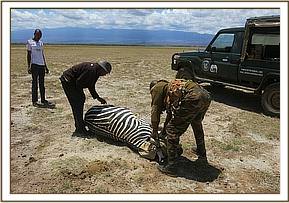
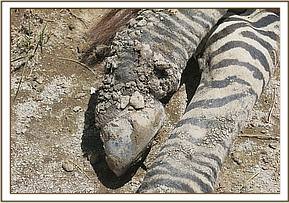
The mud was peeled off, exposing a septic wound about five centimeters diameter at the fetlock joint laterally and distal to it was a ripe abscess almost of same size. These injuries seemed to have arisen from territorial fights as there were also accompanying skin lacerations on the gluteal muscles and neck depicting bites from counterparts. The abscess was aspirated and discharged yellowish pus. The abscess was drained by incising the ripe apex using a surgical blade which yielded lumps of thick yellow pus. Both the wound and lanced abscess were cleaned using Hydrogen Peroxide and Tincture of Iodine. 10 grams of Cloxacillin antibacterial ointment was infiltrated into both dead spaces created by debridement and lavage. Systemically it was injected with 15000mgs Amoxicillin, 30ml Cyanocobalamine and 10mgs Flunixin Meglumine at different muscle sites to cater for opportunistic pathogens, induce appetite and reduce pain respectively.

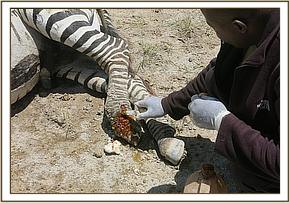
Reversal
The anesthetic was reversed using 10mgs Naltrexone mixed with 6mgs Diprenorphine injected into the jugular vein after eleven minutes of treatment. The zebra was on all four in three minutes and walked slowly away from the treatment site.
Prognosis
It has good prognosis because only soft tissue was involved.
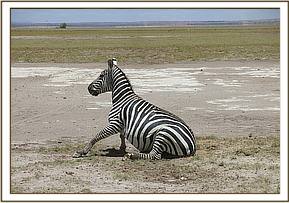
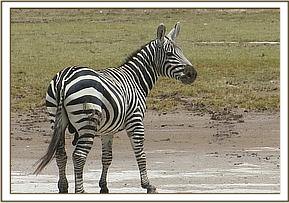
CASE #5 LAME ELEPHANT
Date: 23/02/2017
Species: Elephant
Sex: Female
Age: Adult
Location: Kimana Sanctuary
History
One of the Big Life Foundation Sargent’s spotted a lame elephant across the Isinet farming area. The elephant was in a group of many elephants who were browsing in Kimana Sanctuary. He immediately reached out to the Amboseli Mobile Vet Unit and issued the GPS. The Vet Unit responded promptly before the group disappeared from the location.
Immobilization, examination and treatment
The Vet Unit were joined by Kimana Sanctuary rangers and went to the location where the lame elephant had been spotted. It was approached quietly so as to make an observation. It was observed that the reported elephant is a well-known candidate who appears lame while on ambulation. This is because its’ right hind limb appears short. In fact this has earned her the nick name ‘KIGURU’. The reporter did not ascertain the nature of lameness before reporting.
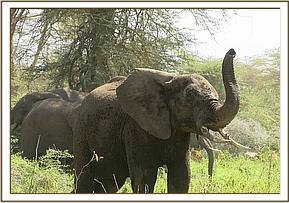
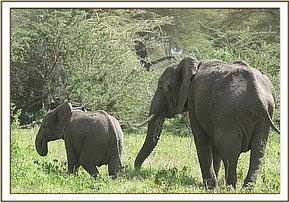
Prognosis
Good. She has been breeding even under the condition. She has the second calf since she was observed with the condition.
CASE#6 PROBLEMATIC LION
Date: 24-26/02/2017
Species: Lion
Sex: Male
Age: Adult
Location: Ngurumani
History
Need to capture and translocate this problematic Lion was necessitated by persistent raiding of cattle bomas within Olkiramatian/Solale/shompole area. The exercise was organized from KWS Headquarters and the Amboseli Mobile Vet Unit joined the Nairobi team at Ngurumani KWS Station which acted as operation base from where the location signals were being monitored from. The lion had raided and predated on a goat on 21/2/2018. Its’ satellite collar indicated that it had covered only 111m in a dense forested escarpment area. It was not clear whether it had finally settled there or it had a health problem impeding movement.
Management
Due to exigency of duties and the difficult terrain the animal was in, it was decided that the ground team would keep monitoring the animal until it moves to suitable ground for easy capture. The vet team would then respond within the shortest time possible.
Acknowledgement
The Vet Unit reckons the enormous support from the David Sheldrick Wildlife Trust. This is coupled with other role players such as the KWS, the Community Conservancy administrators and Non-governmental Organizations. It is through formidable team work that all of the tasks as experienced above have been impeccably executed.




































